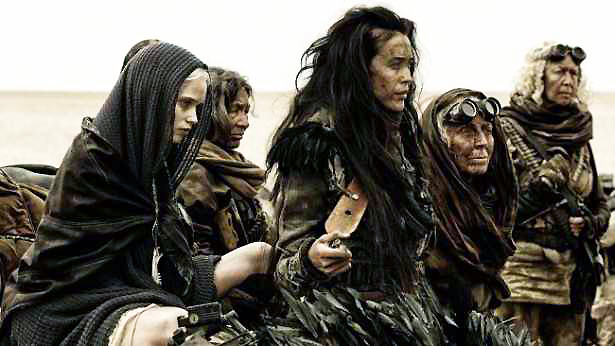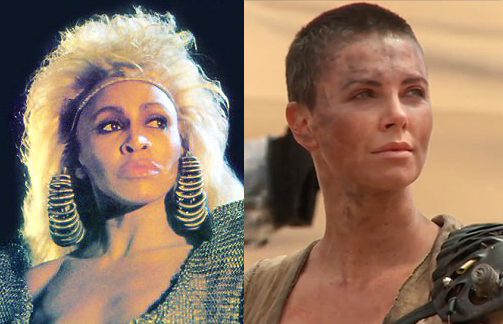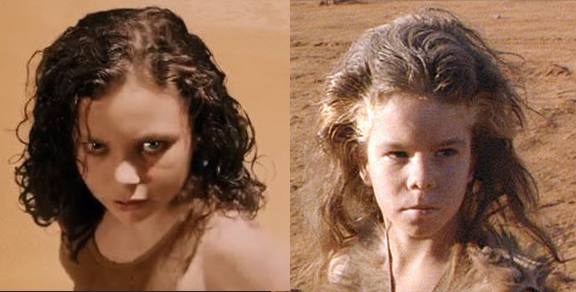Mad Max : Feral Orphans and Chosen Families
“Tell me who you loved, the rest is dross.”
— Oysterband, “The Boy’s Still Running”
Note: I will not revisit important points raised by other reviewers (links at the end of the article). Instead this article will focus on the larger context of the Mad Max universe.
———
I’ve seen all four Mad Max films. In my view, they don’t constitute a series but variations on themes beloved by storytellers (and listeners) since we acquired language: the reluctant loner hero; the creation of kinship by choice; plus, of course, derring-do with fast chariots.
The first draft, Mad Max, is essentially throat-clearing on George Miller’s part. Mel Gibson still carries baby fat. So does the film, a by-the-numbers Bronson-style revenge fantasy fueled by the standard family-fridging event. It’s really a prelude to the sand-blasted hellscape of the successors in which society has regressed to least common denominators: young men as expendable weapons, fertile women and their children as owned assets.
The second take, The Road Warrior, is widely acknowledged as one of the apexes of action B-movies and one of the cornerstones of the post-apocalyptic film subgenre. Everything is pared down to bare essentials: dialogue, scenery, plot, Gibson. The only flamboyant notes are the outré costumes of Max’s opponents, a blend of cyberpunk and faux-tribal. There’s a half-hearted concession to the value of forging kinship bonds, but Miller opts for the Damnation Alley alternative: the potential new kin are slaughtered like Leonidas’ Spartans, an inevitable outcome of the decision to act as sacrificial decoys. This includes the woman who may be too “feisty” to pass on her genes or attitudes. The sole named survivors are the Gyro Captain – Sanzo Pancha to Max’s Quixote – and the Feral Kid, of whom more anon.
The third pass on the by-now-mythic franchise, Beyond Thunderdome, split reviewers – no surprise, as it’s two films. One continues the depiction of Max as a cross between Shane and Moses. This culminates with his descent upon a tribe of lost children stranded in a pocket Eden, whom he reluctantly must lead back to what’s left of urban civilization. There are again attempts at kinship, but Max remains outside the cooperation circle: as with Achilles, whatever he does is entirely from/for his own sense of amour-propre.
But there’s a second strand: Bartertown, struggling to make do in a desert empty of father gods. Crucially, Bartertown is shown as viable (if riddled with inequities), not dependent on gasoline… and ruled by a older woman king. Tina Turner’s formidable poise as Entity and her Pharaoh-like hairdo accentuate these points – plus she delivers a Parthian shot to would-be messiahs: “Today cock of the walk, tomorrow a feather duster.” It’s indicative of the direction Miller’s thoughts were taking that he allows Entity to survive and continue leading Bartertown, even if she’s stranded in the wilderness like Lilith. Not for her the glow of resurgent cities “when they sees the distant light, and they’ll be comin’ home.” It’s this strand that becomes dominant in the fourth variation, car chase ecstasies aside.
When Fury Road appeared to near-universal acclaim, its subversive slant was duly noted by endorsers and detractors alike. Max is a secondary player in this round, he essentially acts as a witness. The pivotal hero – as is made explicit by the male form of her signifier adjective – is Imperator Furiosa. Much has been made of her central placement; but she doesn’t merely incorporate most of the stoic loner protector attributes hitherto allotted to Max. In fact, she’s a younger, more palatable version of Entity – because her dreams are not of hifalutin honor but of community and of survival beyond brutal coercion.
Underneath the heroism (and notwithstanding the unsubtle discussion of “redemption”), Furiosa is a competent pragmatist with a strong humane streak – an engineer, if you will. Like Entity, she probably did a lot of amoral or immoral things to get where she is. In many ways, she’s an alt-universe Anakin complete with the Cain mark of the prosthetic arm.
Whereas Entity is the proverbial lone Smurfette in Thunderdome (as is Savannah Nix among the lost children), in Fury Road Miller reverses the usual gender ratio – and focus – of action films. Immortans Joe’s War Boy horde consists of undifferentiated bobbing blurs punctuated by grotesques calculated to arouse limbic responses. In marked contrast, the women surrounding Furiosa are not only many and foregrounded; they’re also sharply delineated and inhabit a wide gamut of individual personalities, each with full agency.
The matriarchal foundation of Fury Road goes beyond just the demonstration that Joe’s rescued wives are more than mere pretty bodies. When Furiosa establishes her bona fides, she recites her matrilines — and crucially, she lists both biological and cultural mothers. And of course the sine qua non is the appearance of the Vuvalini, the eternally invisible old(er) women, the wise crones who fight without fanfare while keeping songs and seeds alive, the socializers of humanity. The name clearly derives from vulva but there’s an additional possible cognate root: “ox” – vouvalos, buffalo, denoting stubborn strength.
What of the two male co-protagonists, Max and Nux? Nux, who resembles the tentative, forlorn kodama of Mononoke Hime, is both literally and metaphorically an embryo: someone who must be (re)born among mothers and fully socialized by grandmothers before he can be accepted into a family. Max, beyond being played by someone other than Gibson, is clearly not the original person/a. My theory is that the character played by Tom Hardy in Fury Road is the Feral Kid of The Road Warrior, now grown up and at a decision fork about who he will become long-term.
There’s a major signifier of this unique provenance: the Max of the first three films had a now-dead son; the guardian spirit of the Fury Road Max is a daughter – one whom he may have, who’s leading him, Ariáthne-like, out of the labyrinth of isolation and away from Minotaurs like Immortans Joe. But she’s not just a helpmeet: she’s an assertive figure who will fit right in as Entity and Furiosa’s descendant, apprentice and successor.
Miller may choose to revert to conventional tropes in the inevitable next film in the cycle. However, if characters remain true to themselves, Furiosa and Entity will not fight like queen bees when they meet. They will trade: Bartertown fuel for Citadel water and food… and civilization may rise in the desert, aided by the many mothers and grandmothers willing and able to weave kinship tapestries. And the strands separated by the one-father – the Polynesians used as milch-cows, the Aboriginals used as miners, the European-descended used as enforcers and missiles – will reblend. It will not be a pyramid but a web, sets of intercalated wheels of equals. But first among equals will be Furiosa, with Entity and the Keeper of the Seeds smiling behind her – and around her, the co-parents of the once-feral kids who will no longer be either kindling or property.
Related Articles:
Grandmothers Raise Civilizations
The Iron Madonna or: Kicking Ass While Female
Where Are the Wise Crones in SF?
“We Must Love One Another or Die”: A Critique of Star Wars
Mystique: The True Leader of the X-Men
The (Warrior) Women Men Don’t See
Other Fury Road Reviews:
Tansy R. Roberts
Laurie Penny
Jacobin Magazine
Leah Schnelbach
Images: 1st, the Vuvalini; 2nd, the women kings: Entity (Tina Turner), Furiosa (Charlize Theron); 3rd, the past and the future: Glory Child (Coco Jack Gillies), Feral Kid (Emil Minty)





This is great, Athena.
I’m so happy you enjoyed it! I wanted to talk of the larger picture, rather than singletons.
I haven’t seen it yet, but I have noticed some online trolls (and I know you have too) hilariously objecting to the “unrealistic” plot of this movie…namely women with agency. I always find it interesting/sad that in movies with fantastical and, really, by any measure completely unrealistic plots through and through, the one things some trolls find unacceptable are the roles of women. Or people of color. It says much more about these “critics,” and our society, sadly, that in fantasy movies the roles of women and people of color are so closely policed.
[I know you are keenly aware of this; not having seen the movie, it’s the one thing that struck me in some online comments…]
I couldn’t agree more. Many of those who found Fury Road “unrealistic” were straightforward. They essentially said, “I don’t pay good money to see chicks with agency!” — just as some Harvard alumni, when admissions were blinded, said “I don’t pay good money to get chicks into Harvard!”